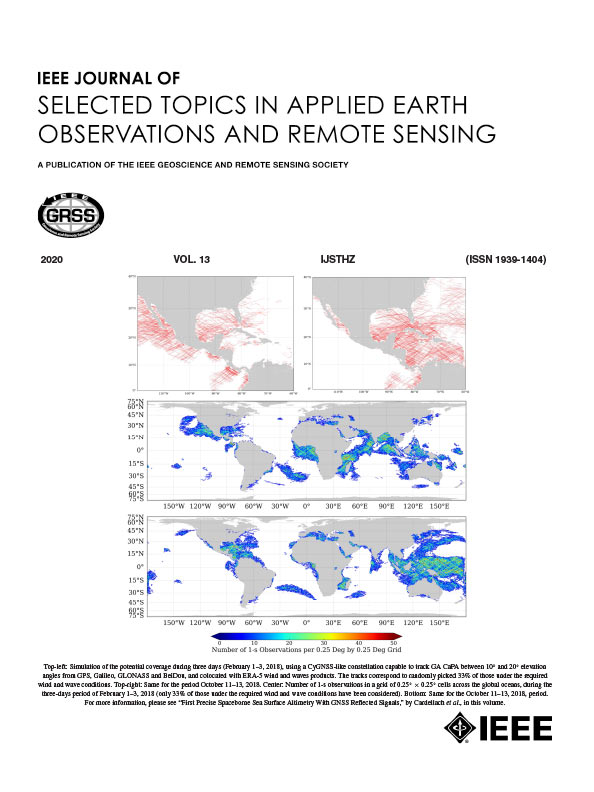基于Sentinel-2 MSI观测和物理方法的珠江三角洲入海口耗氧有机污染物时空监测
IF 5.3
2区 地球科学
Q1 ENGINEERING, ELECTRICAL & ELECTRONIC
IEEE Journal of Selected Topics in Applied Earth Observations and Remote Sensing
Pub Date : 2025-08-25
DOI:10.1109/JSTARS.2025.3602464
引用次数: 0
摘要
河口生态系统受到人为活动和自然过程的影响,需要对复杂的有机污染进行先进的监测。高锰酸盐指数(以高锰酸钾(KMnO4)为氧化剂的化学需氧量,CODMn)是中国环境监测系统的主要参数,但其在河口环境中的应用仍具有挑战性。现有的监测方法主要是经验性的,并且是为内陆水体和大规模沿海地区设计的,没有充分解决以复杂的水动力相互作用和沉积物动力学为特征的河口环境。由于采样数据的稀缺性和在多变地貌条件下的代表性差,这些方法面临着显著的局限性。本研究利用Sentinel-2多光谱数据开发了一种基于物理的反演模型,以克服这些挑战。模型具有稳健性(R2 = 0.7838,平均绝对百分比差(MAPD) = 13.9%,均方根偏差(RMSD) = 0.3791 mg/L,平均归一化差(MND) =−5.99%),优于比较模型。通过对珠江4个主要河口的时空分析,首先发现CODMn浓度从近河口段向河口段急剧下降,在河口段与河口外海岸交界处有明显的富集。四个驱动因素(即陆地有机质输入增加、降雨的季节性变化、城市污水基础设施管理不足和河口工程改造)调节污染物的运输途径和停留时间。该研究为过渡性生态系统有机污染动态监测提供了新的思路,为过渡性生态系统的适应性管理策略提供了支持,特别是为人为压力河口污染源识别、修复效果评估和生态恢复规划提供了新的思路。本文章由计算机程序翻译,如有差异,请以英文原文为准。
Spatiotemporal Monitoring of Oxygen-Consuming Organic Pollutants in the Pearl River Delta Estuaries Based on Sentinel-2 MSI Observations and Physics-Based Approach
Estuarine ecosystems, influenced by anthropogenic activities and natural processes, require advanced monitoring for complex organic pollutions. The permanganate index (chemical oxygen demand using potassium permanganate (KMnO4) as oxidant, CODMn) is a principal parameter in China’s environmental monitoring system, yet its application in estuarine environments remains challenging. Existing monitoring approaches are predominantly empirical and designed for inland water bodies and large-scale coastal regions, leaving estuarine environments characterized by complex hydrodynamic interactions and sediment dynamics insufficiently addressed. These approaches face significant limitations due to sampling data scarcity and poor representativeness under variable geomorphologic conditions. This study developed a physics-based inversion model, using Sentinel-2 multispectral data, to overcome these challenges. The model achieved robust performance (R2 = 0.7838, mean absolute percentage difference (MAPD) = 13.9%, root-mean-square deviation (RMSD) = 0.3791 mg/L, mean normalized difference (MND) = −5.99%), and outperformed the comparison models. Spatiotemporal analysis across four major Pearl River estuaries first revealed a sharp decline in CODMn concentration from the near-mouth section toward the river-mouth section, with pronounced accumulation identified at the boundary between the river-mouth section and the mouth-outside seashore. Four driving factors (i.e., increased terrestrial organic matter inputs, seasonal variations in rainfall, inadequate urban wastewater infrastructure management, and estuarine engineering modifications) regulate the transport pathways and residence time of pollutants. This study provides new insights for the dynamic monitoring of organic pollution, supporting adaptive management strategies in transitional ecosystems, particularly for pollution source identification, remediation effectiveness assessment, and ecological restoration planning in anthropogenically stressed estuaries.
求助全文
通过发布文献求助,成功后即可免费获取论文全文。
去求助
来源期刊
CiteScore
9.30
自引率
10.90%
发文量
563
审稿时长
4.7 months
期刊介绍:
The IEEE Journal of Selected Topics in Applied Earth Observations and Remote Sensing addresses the growing field of applications in Earth observations and remote sensing, and also provides a venue for the rapidly expanding special issues that are being sponsored by the IEEE Geosciences and Remote Sensing Society. The journal draws upon the experience of the highly successful “IEEE Transactions on Geoscience and Remote Sensing” and provide a complementary medium for the wide range of topics in applied earth observations. The ‘Applications’ areas encompasses the societal benefit areas of the Global Earth Observations Systems of Systems (GEOSS) program. Through deliberations over two years, ministers from 50 countries agreed to identify nine areas where Earth observation could positively impact the quality of life and health of their respective countries. Some of these are areas not traditionally addressed in the IEEE context. These include biodiversity, health and climate. Yet it is the skill sets of IEEE members, in areas such as observations, communications, computers, signal processing, standards and ocean engineering, that form the technical underpinnings of GEOSS. Thus, the Journal attracts a broad range of interests that serves both present members in new ways and expands the IEEE visibility into new areas.

 求助内容:
求助内容: 应助结果提醒方式:
应助结果提醒方式:


